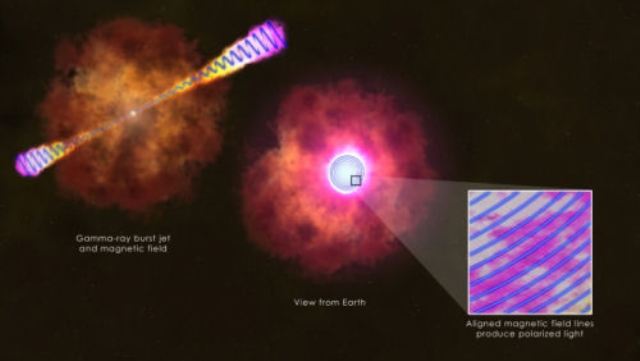Dec 11 2013
The Liverpool Telescope, owned and operated by LJMU’s Astrophysics Research Institute was fitted with an instrument named RINGO2, which Professor Carole Mundell's Gamma Ray Burst team designed to detect any preferred direction, called polarization, in the vibration of light waves from burst afterglows.

The shoe-box-sized instrument pairs a spinning polarizing filter with a super-fast camera. It is mounted on the Liverpool Telescope, which is the world's largest fully autonomous robotic telescope, which then responds automatically to notification from NASA's Swift satellite when it discovers new GRBs.
As reported recently in Nature, the detection of highly polarized light from a burst in March 2012, and the evolution of this afterglow with time, show that gamma-ray bursts contain large-scale, uniform magnetic fields that can survive long after the initial explosion.
Energy across the spectrum, from radio waves to gamma rays, is emitted when a jet slams into its surroundings and begins to decelerate. This results in the formation of an outward-moving shock wave. At the same time, a reverse shock wave drives back into the jet debris, also producing bright emission.
"One way to picture these different shocks is by imagining a traffic jam," Mundell said. "Cars approaching the jam abruptly slow down, which is similar to what happens in the forward shock. Cars behind them slow in turn, resulting in a wave of brake lights that moves backward along the highway, much like the reverse shock."
Previous observations of optical afterglows detected polarizations of about 10 percent, but they provided no information about how this value changed with time. As a result, they could not be used to test competing jet models.
"Just four minutes after it received Swift's trigger, the telescope found the burst's visible afterglow and began making thousands of measurements," said lead researcher Carole Mundell, who heads the gamma-ray burst team at LJMU’s Astrophysics Research Institute.
Professor Carole Mundell and colleagues now report the detection of visible light with 28% polarization in the gamma-ray burst GRB 120308A, four minutes after its initial outburst. Over ten minutes, the degree of polarization decreased to 16%, but the polarization angle remained remarkably stable - supporting the existence of a globally ordered magnetic field, and ruling out a field produced by local instabilities.
Theoretical models of gamma-ray bursts predict that light from the reverse shock should show strong and stable polarized emissions if the jet possesses a structured magnetic field originating from the environment around the newly-formed black hole, thought to be the "central engine" driving the burst.
"This is a remarkable discovery that could not have occurred without the lickety-split response times of the Swift satellite and the Liverpool Telescope," said Neil Gehrels, the Swift principal investigator at NASA's Goddard Space Flight Center in Greenbelt, Md.
Professor Mike Bode, Director of the Astrophysics Research Institute at Liverpool John Moores University, and founder of the Liverpool Telescope, said:
"When I mooted the idea of a robotic telescope nearly 25 years ago, I took a bet that transient phenomena would become an important focus for research in astronomy. That's been vindicated over the Liverpool Telescope's first decade of operation, and this new result shows that our technological lead in rapid response is revolutionising our understanding of some of the most important astrophysical processes."
As well as providing new insight into the physical mechanisms of the most powerful and distant explosions in the Universe, this discovery of highly polarised light from this GRB afterglow may pave the way for future space missions.
Lord Martin Rees of Ludlow, Professor of Astrophysics and Cosmology (University of Cambridge) and Astronomer Royal commented: "By homing in on this burst within a few minutes of its detection by the Swift Spacecraft, the Liverpool telescope has revealed surprising new clues to the mechanisms that power the most powerful known explosions in the universe".
Professor Roger Blandford, Director of the Kavli Institute for Particle Astrophysics and Cosmology (KIPAC) at Stanford University, said:
"This is exciting result strongly supports long-held theoretical ideas. The large optical polarization detected by the Liverpool Telescope in this gamma-ray burst is the imprint of a strong and organized magnetic field. In turn, it seems these fantastic cosmic explosions are powered magnetically, like a solar flare, and not by radiation, like the big bang."
Professor Enrico Costa, ex-Director of Research at the Institute of Space Astrophysics and Cosmic Physics (Rome, Italy) and winner of the 2011 Shaw prize said:
"This is one of the most important results in the past 40-year history of observations of Gamma Ray Bursts - one of the few giving a straightforward interpretation in terms of physics of the object.
"It is very important to extend these measurements to X-rays and this could be accomplished by including a burst monitor and X-ray polarimeter on the recently approved ESA mission ATHENA+. The technology exists and ATHENA+ could be kitted out easily and inexpensively to be a prime GRB facility for the coming decades."
Professor Tsvi Piran, Schwartzmann University Chair at the The Hebrew University, Israel and world expert on Gamma Ray Bursts said: "The nature of the relativistic jets that operate is one of the most intriguing puzzles concerning Gamma-Ray bursts. These observations that indicate that the jets are baryonic but have a strong ordered magnetic field are a major step towards understanding the nature of these jets and of the central engines that produce them."
The story was covered by international media including Science Daily http://www.sciencedaily.com/releases/2013/12/131204182431.htm
The paper, 'Highly polarized light from stable ordered magnetic fields in GRB 120308A' is available at:
http://www.nature.com/nature/journal/v504/n7478/full/nature12814.html
NASA Release: http://www.nasa.gov/content/goddard/glimpsing-the-infrastructure-of-a-gamma-ray-burst-jet
Source: http://www.ljmu.ac.uk